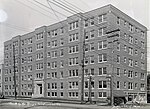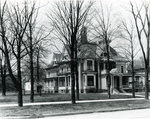Lansing station (Canadian National Railway)
Former Grand Trunk Western Railroad stationsFormer railway stations in MichiganJacobethan architectureMichigan State Historic Sites in Ingham CountyNational Register of Historic Places in Lansing, Michigan ... and 3 more
Railway stations in the United States closed in 1971Railway stations in the United States opened in 1902Railway stations on the National Register of Historic Places in Michigan

The Grand Trunk Western station was a historic railroad station in Lansing, Michigan. The station was listed as a Michigan State Historic Site in 1978, and it was added to the National Register of Historic Places in 1980.
Excerpt from the Wikipedia article Lansing station (Canadian National Railway) (License: CC BY-SA 3.0, Authors, Images).Lansing station (Canadian National Railway)
East South Street, Lansing
Geographical coordinates (GPS) Address Nearby Places Show on map
Geographical coordinates (GPS)
| Latitude | Longitude |
|---|---|
| N 42.719444444444 ° | E -84.551388888889 ° |
Address
East South Street
48910 Lansing
Michigan, United States
Open on Google Maps










